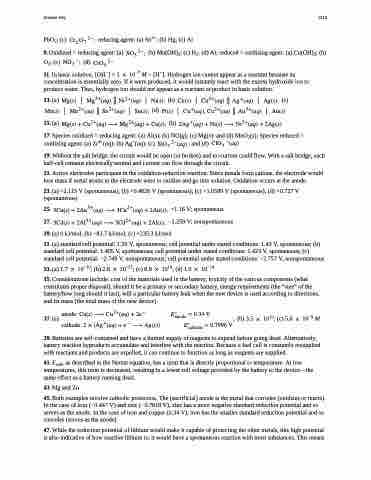Page 1325 - Chemistry--atom first
P. 1325
Answer Key 1315
PbO2; (c) ��� �� ��� reducing agent: (a) Sn2+; (b) Hg; (c) Al
9. Oxidized = reducing agent: (a) ��� ��� (b) Mn(OH)2; (c) H2; (d) Al; reduced = oxidizing agent: (a) Cu(OH)2; (b)
O2; (c) ��� �� (d) ���� ��
11. In basic solution, [OH−] > 1 � 10−7 M > [H+]. Hydrogen ion cannot appear as a reactant because its concentration is essentially zero. If it were produced, it would instantly react with the excess hydroxide ion to produce water. Thus, hydrogen ion should not appear as a reactant or product in basic solution.
13. (a) ����� � �������� � �������� � ������ (b) ����� � �������� � ������� � ������ (c) ����� � �������� � �������� � ������ (d) ����� � �������� �������� � �������� � �����
15. (a) ����� � �������� � �������� � ������ (b) �������� � ����� � �������� � ������
17. Species oxidized = reducing agent: (a) Al(s); (b) NO(g); (c) Mg(s); and (d) MnO2(s); Species reduced =
oxidizing agent: (a) Zr4+(aq); (b) Ag+(aq); (c) ���� ������ ; and (d) ���� �����
19. Without the salt bridge, the circuit would be open (or broken) and no current could flow. With a salt bridge, each
half-cell remains electrically neutral and current can flow through the circuit.
21. Active electrodes participate in the oxidation-reduction reaction. Since metals form cations, the electrode would lose mass if metal atoms in the electrode were to oxidize and go into solution. Oxidation occurs at the anode.
23. (a) +2.115 V (spontaneous); (b) +0.4626 V (spontaneous); (c) +1.0589 V (spontaneous); (d) +0.727 V (spontaneous)
25. ������ � ��������� � ��������� � ������� +1.16 V; spontaneous
27. ������ � ��������� � ��������� � ������� −1.259 V; nonspontaneous
29. (a) 0 kJ/mol; (b) −83.7 kJ/mol; (c) +235.3 kJ/mol
31. (a) standard cell potential: 1.50 V, spontaneous; cell potential under stated conditions: 1.43 V, spontaneous; (b) standard cell potential: 1.405 V, spontaneous; cell potential under stated conditions: 1.423 V, spontaneous; (c) standard cell potential: −2.749 V, nonspontaneous; cell potential under stated conditions: −2.757 V, nonspontaneous
33. (a) 1.7 � 10−10; (b) 2.6 � 10−21; (c) 8.9 � 1019; (d) 1.0 � 10−14
35. Considerations include: cost of the materials used in the battery, toxicity of the various components (what constitutes proper disposal), should it be a primary or secondary battery, energy requirements (the “size” of the battery/how long should it last), will a particular battery leak when the new device is used according to directions, and its mass (the total mass of the new device).
������ ����� � �������� � ���
37. (a) � � � �
�� � ���� � �����
� (b) 3.5 � 1015; (c) 5.6 � 10−9 M �������� � � ��� ���� � � � ������ �� � ������ �
39. Batteries are self-contained and have a limited supply of reagents to expend before going dead. Alternatively, battery reaction byproducts accumulate and interfere with the reaction. Because a fuel cell is constantly resupplied with reactants and products are expelled, it can continue to function as long as reagents are supplied.
41. Ecell, as described in the Nernst equation, has a term that is directly proportional to temperature. At low temperatures, this term is decreased, resulting in a lower cell voltage provided by the battery to the device—the same effect as a battery running dead.
43. Mg and Zn
45. Both examples involve cathodic protection. The (sacrificial) anode is the metal that corrodes (oxidizes or reacts). In the case of iron (−0.447 V) and zinc (−0.7618 V), zinc has a more negative standard reduction potential and so serves as the anode. In the case of iron and copper (0.34 V), iron has the smaller standard reduction potential and so corrodes (serves as the anode).
47. While the reduction potential of lithium would make it capable of protecting the other metals, this high potential is also indicative of how reactive lithium is; it would have a spontaneous reaction with most substances. This means
�������


